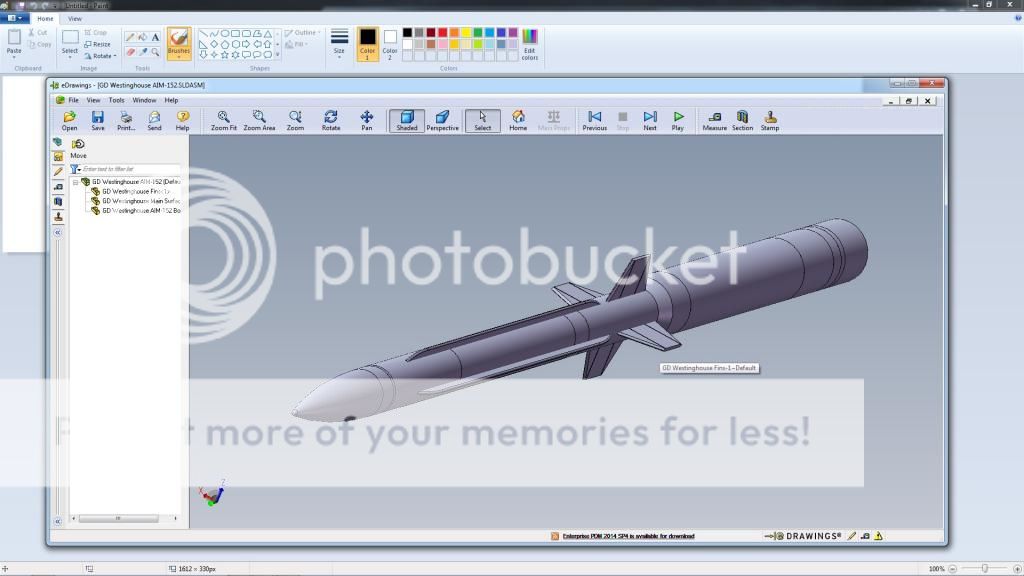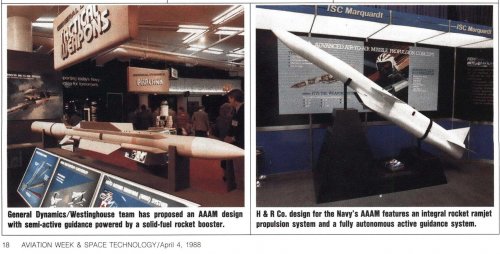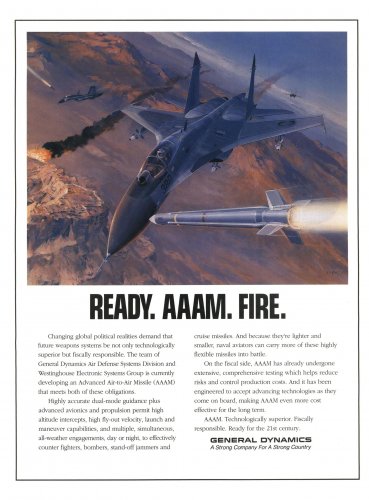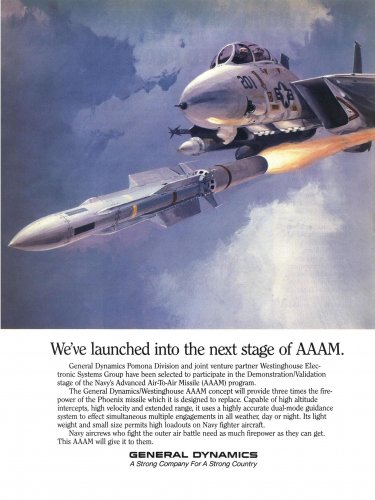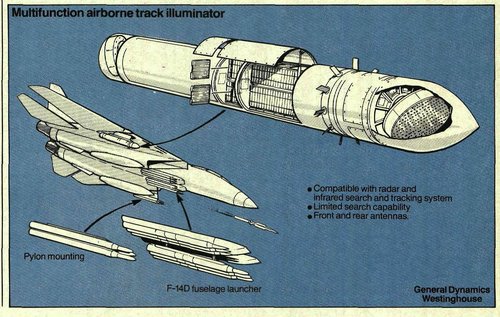The Hughes Phoenix long-range, air-to-air fleet-defence missile system is the most complex and capable in service. Hughes has teamed up with Raytheon to bid for its successor. These companies are pre-eminent in the air-toair missile business, but a "dark horse" team of General Dynamics and Westinghouse could give them a good run for their money, with an innovative design which owes much to GD's surface-to-air experience. Doug Richardson reports.
In the mid to late 1990s, the Soviet Air Force is likely to deploy stealthy strike aircraft and bombers equipped with long-range air-to-surface weapons, including cruise missiles. Defence against such advanced threats will be difficult, but the US Navy already has a weapon on the drawing board for use in what it terms the "Outer Air Battle". This is a missile with about twice the range of the AIM-54 Phoenix, better high altitude capability, and dual-mode radar/ electro-optical (EO) guidance. If the advanced medium-range air-to-air missile (AMRAAM) could be defined as an attempt to pack Phoenix performance into a missile of Sparrow size, the Advanced Air to Air Missile (AAAM or "A cubed M") can be considered as a plan to cram Phoenix-plus performance into a missile even lighter than Sparrow. That reduction in size and weight is important, because it will allow US Navy F-14 Tomcats to land on a carrier while carrying eight long-range missiles, rather than the Phoenix.
In October 1988 the US Navy's Naval Air Systems Command (NAVAIR) awarded contracts to two industrial teams for a four year technology-validation phase of the AAAM. One team was a combination of Hughes and Raytheon, two rival companies which have come to dominate the US market for medium/long-range air-to-air missiles. The other links General Dynamics with Westinghouse.
Under a programme known as the Advanced Missile System (AMS), GD has studied technology for long range air-to-air missiles for more than a decade. The first practical results to emerge, in the late 1970s, were a new five-cavity klystron microwave tube, the construction of a demonstration integrated-guidance section and integrated missile receiver, and the testing of an experimental Interrupted Continuous Wave (ICW) transmitter. The latter was strictly lab-test hardware - it filled a two-bay electronics rack - but provided the experience needed to propose ICW technology for the AAAM semi-active radar seeker. Using ICW technology, the launch aircraft can "time manage" its radar, switching the beam from one target to another in rapid succession so that this single illuminator can handle a multiple engagement.
By the end of the decade a full-scale airframe had been built. Looking rather like a stretched Standard surface-to-air missile (SAM), this featured long-chord cruciform wings and narrow-chord cruciform tail fins, plus a short tandem-rocket booster. The missile is 12ft long (3.65m), 5.5in (140mm) in diameter, and weighs 386lb (175kg). A first-generation seeker gimbal and a second-generation control section were tested in the early 1980s, while 1983 saw trials on a ground test stand of a heavy-walled prototype of the proposed rocket motor and thrust-vector control (TVC) system. Other tests checked the performance of the proposed warhead against what were described as "RA-5-size targets". A second series of windtunnel tests on the missile airframe began in 1983. The EO guidance mode was tested in 1984/5 during a series of flyover tests carried out by day and night.
The GD/Westinghouse missile has folding wing and tail surfaces, and is delivered from the depot packed in a circular storage/launch tube. The team has released artwork showing how 12 of these tubes could be carried in two lateral rows of six under the fuselage of an F-14D.
Tomcat will also need to carry a multifunction airborne track illuminator (ATI) pod, either on one of its fuselage stations or an underwing pylon. This unit is 11ft 10in (3.6m) long, 16in (406mm) in diameter, and weighs 750lb (341kg). It is self-powered by a ram-air turbine whose vanes are located about a quarter of the way from the forward end. On the US Navy's next-generation fighter, currently expected to be a derivative of the USAF's Advanced Tactical Fighter, the functions of the ATI will be handled by the aircraft's Westinghouse-developed radar.
Finding and tracking
Targets would be detected initially either by the F-14D's APG-71 radar or by its infrared search and track system (IRST), then handed over to the ATI pod. This uses its frontfacing antenna to track the targets and compute the engagement envelope for each one. It also has a limited degree of search capability. The aircrew selects the target to be engaged, then fires the missile. The round will leave the launch tube under the power of its tandem-mounted rocket booster. At burnoutthis will be jettisoned, and the main solid-propellant rocket motor (sustainer) ignited to power the round for the first stage of its flight out to the target. After launch, the crew is free to manoeuvre its aircraft to reduce the closure rate. There is no need to keep the aircraft pointed towards the target - a drawback to conventional semi-active radar-homing-missile attacks. The ATI pod even has a second rearward-facing antenna.
Like the Hughes AIM-120 AMRAAM, AAAM will fly an optimised trajectory under the control of an inertial midcourse guidance system. Uplink facilities are provided, so that the parent aircraft can transmit targeting updates should these be needed. In the later stages of flight, the missile activates its terminal guidance seeker. Still later, the radome is jettisoned, allowing the missile's infrared seeker to begin operation.
Home-on-jam attacks are also possible. While the sustainer is burning, its jet-tab thrust vectoring control (TVC) system will supplement the missile's aerodynamic control surfaces. This will probably be of greatest importance when engaging targets flying at high altitude. In such cases, the sustainer is re-ignited for a second burn. This extra power, plus the use of TVC, is expected to allow the missile to have the same manoeuvrability at 100,000ft (30,500m) as today's Sparrow has at 20,000ft (6,000m). "
The rival Hughes/Raytheon team has proposed a more radical design which combines active radar and EO guidance for full "fire-and-forget" capability, and is powered by an integral rocket /ramjet rather than a solid-propellant rocket. This missile would be mounted on an aircraft in the normal manner, and a Hughes/Raytheon drawing shows eight on an F-14D - two under each wing, one on either side of the lower fuselage just below the inlets, and two in tandem on the centreline.
Although this team has released less written information of its proposed weapon, it has issued a detailed drawing of the missile's internal arrangement, including the integral rocket/ramjet propulsion system. On the Hughes/Raytheon AAAM design, the inlet is mounted beneath the fuselage and just ahead of the low-set wings. Directly above is a large tank which houses the liquid fuel which is injected into the ramjet combustion chamber. Air-breathing powerplants are more complex than solid rockets, but are more efficient as a result of using air rather than an oxygen-bearing compound in the propellant charge, to support combustion.
Tit for tat
One published report has suggested that, although the Hughes/Raytheon missile will have a lower acceleration than that of the rival GD / Westinghouse design, the airbreathing missile will be faster at ranges beyond about two-thirds of maximum. The GD/Westinghouse team claims that its rocket sustainer "expands the high-altitude envelope, where air-breathing missiles cannot operate". Given that the ramjet powered Talos SAM used by the US Navy in the 1960s and early 1970s was credited with a ceiling of more than 85,000ft (26,000m), the question remains of just how high a ceiling this team has in mind.
Another surprise in the Hughes/Raytheon design is the use of a single pair of wings, rather than the cruciform configuration which is a feature of most other present-day designs. Like a manned aircraft, the missile will have to bank as it turns, a technique known in the missile industry as "twist and steer". First used in the early 1940s on the world's first air-to-air guided missiles—the Henschel Hs 298 and the Ruhrstahl X-4 - the technique saw little post-war service other than on a few early air-to-air missiles built in the 1950s, such as the Sispre C-7 and Matra's R510 and 511, and on the Bristol/Ferranti Bloodhound SAM. The feature which has made "twist and steer" attractive for AAAM is its efficiency. Less energy is wasted by banked turns than by the skidding turns which result from the use of conventional cruciform surfaces.
The guidance system is based around a reprogrammable computer. An imaging seeker (probably an IR device) is mounted at the tip of a radome covering the antenna of the active-radar seeker. A short section of the fuselage just forward of the fuel tank is occupied by the warhead. This is teamed with adaptive fuzing to ensure optimum triggering distance against targets of all types.
Under present plans, full-scale development of the winning design should begin in 1992. This is expected to run for four years, ending in 1996. The US Navy intends to buy 4,000 rounds to arm the F-14D, F/A-18, and the new A-12 Advanced Tactical Aircraft. The USAF has its own plan to develop a new air-to-air missile, an improved version of the AIM-120A AMRAAM, and currently claims to have no requirement for a missile in the class of AAAM. Congress is sceptical, however, and would like to see AAAM made a joint USAF/USN programme.





